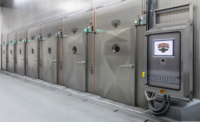Finding the best packaging for merchandising poultry can be vexing.
While foam tray overwrap is the dominant form of poultry packaging, there is a growing consumer demand for packing made from sustainable materials and an interest in designs that enhance food safety and lengthen product shelf life, analysts say.
“Consumer concerns about responsibly raised chicken has broadened in recent years to include responsibly packaged chicken,” says Tom Super, senior vice president of the Washington, D.C.-based National Chicken Council. “While the COVID-19 pandemic may have caused supermarket food shoppers to hit the pause button on the packaging issue, it has not disappeared from their radar screens.”
He says consumers are evaluating the “total bundle of attributes” when making chicken-buying decisions.
Shoppers’ packaging concerns primarily focus on fresh tray-pack chicken that features polystyrene foam or paperboard trays with a flexible clear film overwrap, Super says, but they also “expect an attractive package that conveys freshness, food-safety integrity and a convenient ease of removing the chicken from the package.”
Packaging must relay key product attributes to shoppers if merchandisers are to differentiate their poultry from those of competitors, says Jim Wisner, president of Wisner Marketing, a Gurnee, Ill.-based market research, education and consumer packaged goods consulting firm. Such claims can include being sustainable, low fat, free range, farm raised, raised without antibiotics, lower in calories, a lower cost per serving versus beef and organic, he says. “Packaging can be as much or more of a competitive differentiator than the product,” Wisner says.
Operators also can help their poultry stand out by including quick response (QR) codes on packaging so shoppers can quickly get more information such as nutrition facts, recipes or videos illustrating how the supplier treats its chickens. “Using QR codes is not expensive,” Wisner says. “It is just that companies are not using it.”
In addition, merchandisers can use the SmartLabel tool to let consumers digitally access more detailed product information, he says.
Consumer research, meanwhile, is necessary for determining the attributes that are most important to shoppers so that packaging is not cluttered with excess information and there is ample room for viewing the poultry, Wisner says. “Shoppers need confidence that the poultry looks fresh and good and is not discolored,” he says. “Hiding the product behind packaging creates nervousness.”
A shift toward flexible and clear packaging enables operators to better display the poultry, says Jorge Izquierdo, vice president of market development for PMMI, the Herndon, Va.-based association for packaging and processing technologies. “Consumers desire to see the products they are purchasing in order to visually verify the freshness,” he says, adding that flexible packaging also is “gaining ground” over rigid packaging in providing performance and sustainability advantages.
The pros and cons of sustainability
While the poultry sector still trails other food categories in the use of sustainable packaging, eco-friendly selections are increasingly prevalent, Izquierdo says. Along with efforts to reduce the amount of packaging material, operators look for wrappings with more recyclable and biodegradable elements, he says. Newer materials include combinations of paper and film to reduce the amount of plastic in packaging.
Adoption challenges remain. Cost and machinability concerns can limit the use of highly sustainable materials, Izquierdo says. And a switch can slow production.
“Moving from one packaging technology to another is generally going to require significant changes on how the product is processed and that will stretch to the shipping endpoint,” Wisner says. “It involves the whole physical way that the products get through the plant and out to the store.” Because such changes may demand significant capital investments, it “requires big decisions” from plant operators on how best to move forward, Wisner says.
Nevertheless, there is strong market demand for packaging that is compostable and can be recycled, Super says. Plastic film and trays made from non-petroleum sources are in development, “but so far these alternatives are cost prohibitive.”
Packaging manufacturers also are looking to use bioplastics and molded fiber materials for fresh proteins, Super says. “A breakthrough on making these products cost competitive will attract much consumer attention. These efforts, coupled with overcoming the challenges to contain moisture, expand the growth horizon of the market.”
Keep cost in perspective
Cost also is the biggest obstacle to using leak-proof and extended-shelf-life packaging, says Huston Keith, principal at Keymark Associates, a Marietta, Ga.-based packaging industry market research and consulting firm. That includes the use of vacuum-sealed and modified-atmosphere packaging (MAP) selections, which are most prevalent in the high-value organic sector, he says. Another option in that sector is recyclable polyethylene terephthalate (PET) packaging, “which has not made serious inroads into mainstream packaging.”
“It is difficult to pass along the higher expense or obtain sales increases to justify the higher cost, except for niche items,” Keith says. “The key to meeting challenges is by having lower cost technology that can provide these benefits.”
Yet, packaging costs can be deceiving. While it is more expensive for processors to use vacuum-sealed and modified-atmosphere packaging, poultry in such packages looks better and lasts longer, Wisner says. “Because the packaging also cuts waste, the actual cost for the retailer and consumer can be less while having a better product, even though all of the components cost more,” he says. “You have to look at the whole picture.”
Retailers that pack chicken may face the challenge of staying competitive with national brands, which have greater resources for marketing chicken in the most functional packaging, Wisner says.
That can include modified-atmosphere packaging, which extends poultry shelf life and reduces food-safety risks by substituting the air inside the package with a protective gas mix, Wisner says. Such gases can include nitrogen to fill the headspace; carbon dioxide, which adds antimicrobial properties; carbon monoxide, which retains color and extends shelf life; and oxygen, which stabilizes the color. Vacuum packaging, which is less expensive than MAP, also removes air from around the product to prevent oxygen-breathing microorganisms to grow, which can result in spoilage.
“Retailers have to ask, ‘What is going to give me the best product in the case?’ and then figure out how to do it as cost effectively as possible,” Wisner says. “Don’t start with cost as the driving point because you will end up making short-term decisions.”
Back to the basics
It is important for poultry processors to have affordable packaging that can protect products in transit, says Rafael Rivera, manager of food safety and production programs for the Tucker, Ga.-based U.S. Poultry and Egg Association.
“Packaging has to keep the product safe and prevent contamination and bacterial outgrowth for food safety and to maintain product quality,” Rivera says, adding that merchandisers can position their eco-friendly packaging as a competitive differentiator.
“Since poultry is a perishable product, the main purpose is to protect it and have as long of a shelf life as possible,” he says. “But with sustainability and food-waste reduction being big topics, we have to consider those issues and communicate what is being done to address that.”
Such considerations include the type of tray and tray materials that operators will use in packaging, cost implications, the speed that plant machinery runs with the different types of packaging and whether the packaging will make the product more competitive in the case, Wisner says. “There are a lot of things for the operators to think about,” he says.
For more information, visit the following suppliers:
BunzlProcessor Division/Koch Supplies
Middleby Food Processing and Packaging




Report Abusive Comment